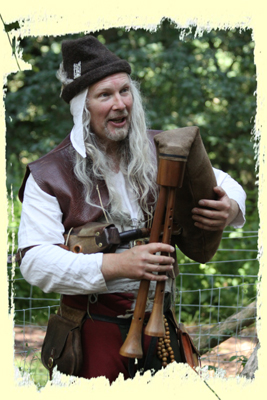|
About
Contact
Events Diary
Historical Settings
Weddings & Parties
School Days
Bowtop Waggon
Testimonials
Bagpipe Music
Myal's Pipes
Links
Videos
CDs
|
 |
What
people played in the early centuries of English piping is open to a wide
interpretation and very little has come down to us. Also, as an
instrument of the lower classes, knowledge was passed
on first hand, with communication and record only being made easier well
into the age of printing
As
with most aspects of English culture, music was also imported
from Europe where (circa mid 16th century) various
Continental composers, such as Susato and Arbeau, were compiling and
publishing collections of tunes for dances, some of which (brawls, for
instance) were pan-European.
Appearing about
the same time is the Hornpipe, it bears little resemblance to the
familiar “sailor’s hornpipe” we know today and the steps to its
dance have not yet come to light. An example of a hornpipe, Mr.
Preston's Hornpipe, early C18th, is linked to this page. |
|
In the 17th century
the
English family, Playford, performed a similar feat to their continental
counterparts, writing down both tune and dance of those popular in their
day, leaving a wealth for the generations that followed.
But at
the same time as the Playfords recorded, the bagpipe in England was an
instrument in decline. Although English composers, such as William Byrd and
Henry Purcell, were
creating music inspired by what they heard about them (Byrd calling one
piece “Bagpipe and Drone”) the music was set to be played on more
“refined” instruments.
However, from the 13th to 17th centuries there remains a sizeable
body of music that is relatively pipe friendly and where the English piping tradition is
largely unbroken (Northumberland and the Borders) the music has developed up to
the present day.
|
|
It is
difficult to know for how long a simple reed instrument has been
attached to a bag. Images of people possibly playing bagpipes are said
to be carved into various works of stone across ancient lands of
the Middle East.
Depending on to whom you talk bagpipes arrival in the British Isles is
due to the Romans and, if not them, then right up through to the Crusaders bringing them back as part of their
prize. And then, if talking to a fervent follower of the "Celtic Fringe", then
bagpipes bypassed most of England entirely! Argument is rife, fact hard to find.
|
|
Along with various
carvings and stained glass extant in churches across the country we also
have a written record, notably Robin the Miller (late 14th century)
leading the pilgrims out of Southwark on his horse playing his bagpipe
in Chaucer's "Canterbury Tales", with somebody scribbling a drawing of
Robin, horse and bagpipe in a copy from the 15th century.
By
the 16th
century we have James IV of Scotland paying for an
English bagpiper to play; Henry VIII, a noted musician, owning 5 sets of
ivory bagpipes, and there were town pipers, such as Henry Halewood, playing in
Liverpool in 1571, well, actually, being hauled up in front of the
local magistrate for playing on a Sunday!
By
the 17th century (1662) Sir
Thomas Browne wrote of his "tour into Derbyshire" “when wee had
viewed this famous towne of Bakewell, wee returned to our inne to
strengthen ourselves against what encounters wee should meet with next;
where at our entrance wee were accosted with the best musick the place
could afford, an excellent bagpipe; and breakfast being ready, I think
our meat danced down our throats, the merrylier.”
However, even as
he wrote, the bagpipe, as a popular instrument in
England, was in decline and the fiddle ascendant.
|